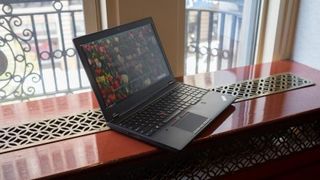Why you can trust TechRadar
Touch, don't swipe
In addition to the Smart Card reader slot, the ThinkPad P70 can also be configured with a fingerprint scanner for security-conscious organizations. Like the trend set by Apple and Samsung in the smartphone market, authentication on the P70 requires a touch, not a swipe, of a finger. If you're using Windows 10, the fingerprint scanner will work with Windows Hello and Microsoft Passport, allowing you to ditch the password for Windows logins.

Lenovo switched to the touch method for scanning fingerprints because it is easier for users, according to Flynn. Whereas the swipe to scan method required users to position their fingers at the proper angle and to swipe at a consistent speed, the touch method just asks users to tap and hold their finger to the scanner embedded on the right-hand side of the keyboard deck.
Battery life
Unlike the ThinkPad W Series, the battery in the ThinkPad P70 is integrated, meaning that it cannot be replaced. The eight-cell battery in the P70 is rated for between five and six hours of use, according to Flynn.
The integrated battery means that Lenovo's Power Bridge Technology won't make an appearance on this year's P Series. On the ThinkPad W550s, there is an internal battery as well as a user-replaceable battery. Power Bridge Technology allows owners of the W550s to swap out the depleted replaceable battery for a fresh one without having to shut down their system. This saves time as you won't need to reopen tabs or relaunch apps because you didn't have to shut down.
We'll have to get the ThinkPad P70 in to evaluate Lenovo's battery life claims. For comparison, the older quad-core Haswell-based ThinkPad W540 lasted just over three hours when benchmarked using PCMark8.

The Intel Skylake CPU should provide for more performance and improved power efficiency than previous generation Haswell and Broadwell processors, so we're optimistic about battery life. However, you'll still want to be within range of a power outlet as Lenovo's battery life numbers still fall short of a full work day.
Early verdict
As one of the first notebooks to come with Intel's powerful Xeon processor family, the Lenovo ThinkPad P70 promises to deliver plenty of performance, to the delight of engineers, graphics and design professionals, video editors and those who require raw computational power while mobile. And even though Lenovo is keeping the tested and trusted ThinkPad design the same, the P70 is a major upgrade from the quad-core Haswell-based architecture of the ThinkPad W541 it replaces.
Lenovo only told us that pricing starts at $1,999 (about £1,290, AU$2,702), but with options for up to 64GB DDR4 RAM, 3TB storage and 4K UHD touchscreen display, we expect the cost to quickly climb for a fully configured system. For comparison, with a 3K display, the highest configuration for the Lenovo W541 comes in at $2,982 (about £1,912, AU$4,022).
If you can afford the price and don't mind losing Lenovo's Power Bridge hot swappable battery technology, the ThinkPad P70 is one of the most powerful mobile systems on the that aims to bring desktop-like productivity in a 7.6-pound package.
What is a hands on review?
Hands on reviews' are a journalist's first impressions of a piece of kit based on spending some time with it. It may be just a few moments, or a few hours. The important thing is we have been able to play with it ourselves and can give you some sense of what it's like to use, even if it's only an embryonic view. For more information, see TechRadar's Reviews Guarantee.

